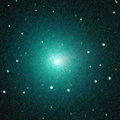
|
It approached to Earth down to 0.3 a.u. in mid February, and brightened up to 5.5 mag (Feb. 13, Juan Jose Gonzalez). Now it is fading. But it is still bright as 7.6 mag (Feb. 27, Carlos Labordena). In the Northern Hemisphere, it is observable in excellent condition. It locates low in the Southern Hemisphere.
Date(TT) R.A. (2000) Decl. Delta r Elong. m1 Best Time(A, h)
Mar. 2 5 20.91 34 59.7 0.725 1.333 100 8.2 19:19 ( 93, 82)
Mar. 9 4 52.98 34 22.0 0.968 1.363 88 8.9 19:25 ( 95, 70)
|
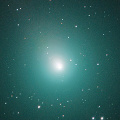
|
It approached to Earth down to 0.08 a.u. in mid December, and it brightened up to 3.4 mag (Dec. 14, Seiichi Yoshida). it looked so large as 3 times of Moon. Now it is fading. It has already faded down to 10.3 mag (Feb. 27, Maik Meyer). In the Northern Hemisphere, it stays observable in excellent condition. In the Southern Hemisphere, it stays low for a while.
Date(TT) R.A. (2000) Decl. Delta r Elong. m1 Best Time(A, h)
Mar. 2 9 38.94 45 27.4 0.567 1.467 139 10.5 23:00 (180, 80)
Mar. 9 9 42.51 43 4.7 0.643 1.525 136 11.2 22:36 (180, 82)
|

|
It brightened up to 7.7 mag in June (June 19, Juan Jose Gonzalez). Now it is fading. But it is still bright as 11.5 mag (Feb. 11, Chris Wyatt). In the Southern Hemisphere, it stays observable in good condition for a long time until the comet will fade out. In the Northern Hemisphere, it is not observable for a long time until autumn when the comet fades out down to 16 mag.
Date(TT) R.A. (2000) Decl. Delta r Elong. m1 Best Time(A, h)
Mar. 2 3 43.97 -61 39.2 3.266 3.170 75 11.8 19:19 ( 16,-10)
Mar. 9 3 55.54 -58 28.9 3.323 3.222 75 11.9 19:25 ( 20, -9)
|

|
Now it is 13.5 mag (Jan. 27, Toshihiko Ikemura, Hirohisa Sato). It will be unobservable temporarily soon. But it will appear in the morning sky again at 13-14 mag in August.
Date(TT) R.A. (2000) Decl. Delta r Elong. m1 Best Time(A, h)
Mar. 2 0 53.06 5 43.3 2.781 2.031 33 12.4 19:19 ( 87, 15)
Mar. 9 1 8.48 7 4.1 2.814 2.024 30 12.4 19:25 ( 91, 12)
|
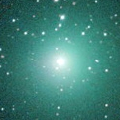
|
It brightened up to 9.0 mag from autumn to winter (Nov. 16, Maik Meyer). Now it is fading. But it is bright as 12.4 mag still now (Feb. 23, Seiichi Yoshida). It is observable in excellent condition in the Northern Hemisphere. It stays low in the Southern Hemisphere.
Date(TT) R.A. (2000) Decl. Delta r Elong. m1 Best Time(A, h)
Mar. 2 5 12.69 25 4.2 1.534 1.945 98 12.9 19:19 ( 47, 76)
Mar. 9 5 27.21 24 41.6 1.653 1.996 94 13.4 19:25 ( 57, 73)
|
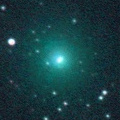
|
Now it is 12.2 mag (Feb. 2, Ken Harikae). It will be fading gradually after this. In the Northern Hemisphere, it stays observable for a long time until it fades out. But it stays extremely low. It will never be observable again in the Southern Hemisphere.
Date(TT) R.A. (2000) Decl. Delta r Elong. m1 Best Time(A, h)
Mar. 2 22 15.70 37 51.5 2.624 2.063 46 13.0 5:05 (234, 15)
Mar. 9 22 39.30 39 25.5 2.695 2.113 44 13.3 4:56 (232, 15)
|
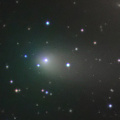
|
It brightened up to 9.5 mag from autumn to winter (Dec. 14, Marco Goiato). Now it is fading. But it is bright as 12.6 mag still now (Feb. 23, Seiichi Yoshida). In the Northern Hemisphere, it stays observable in good condition for a long time until it fades out. It locates low in the Southern Hemispehre.
Date(TT) R.A. (2000) Decl. Delta r Elong. m1 Best Time(A, h)
Mar. 2 8 30.16 46 5.6 1.302 2.092 131 13.1 21:51 (180, 79)
Mar. 9 8 34.01 45 12.4 1.401 2.145 126 13.5 21:28 (180, 80)
|
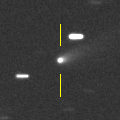
|
Now it is 12.4 mag (Feb. 24, Juan Jose Gonzalez). It is observable in excellent condition in the Northern Hemisphere. It locates low in the Southern Hemisphere.
Date(TT) R.A. (2000) Decl. Delta r Elong. m1 Best Time(A, h)
Mar. 2 11 25.76 31 58.1 1.200 2.136 154 13.3 0:50 ( 0, 87)
Mar. 9 11 19.84 31 48.4 1.209 2.142 152 13.3 0:17 ( 0, 87)
|
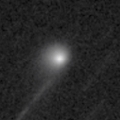
|
Now it is 14.6 mag (Jan. 22, Thomas Lehmann). It will brighten up to 10-11 mag in autumn. It will be unobservable temporarily in March.
Date(TT) R.A. (2000) Decl. Delta r Elong. m1 Best Time(A, h)
Mar. 2 1 16.22 -18 17.4 4.693 3.951 37 13.3 19:19 ( 64, 5)
Mar. 9 1 20.06 -16 33.6 4.710 3.912 32 13.3 19:25 ( 70, 0)
|
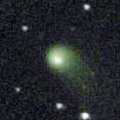
|
Now it is 13.3 mag (Feb. 9, Chris Wyatt). It stays 13-14 mag until summer.
Date(TT) R.A. (2000) Decl. Delta r Elong. m1 Best Time(A, h)
Mar. 2 17 32.72 -21 10.0 3.351 3.277 77 13.8 5:05 (330, 28)
Mar. 9 17 31.94 -22 40.6 3.232 3.286 84 13.7 4:56 (336, 28)
|

|
Now it is 13.0 mag (Feb. 4, Chris Wyatt). It will be fading after this.
Date(TT) R.A. (2000) Decl. Delta r Elong. m1 Best Time(A, h)
Mar. 2 5 42.14 -21 34.7 3.238 3.537 99 13.7 19:19 ( 5, 33)
Mar. 9 5 38.18 -21 14.1 3.381 3.582 93 13.9 19:25 ( 15, 32)
|
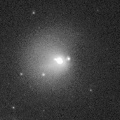
|
It is not observable now. It will appear in the morning sky in May.
Date(TT) R.A. (2000) Decl. Delta r Elong. m1 Best Time(A, h)
Mar. 2 23 38.34 4 5.6 6.708 5.767 16 13.8 19:19 ( 96, -2)
Mar. 9 23 43.60 4 41.3 6.735 5.767 11 13.8 19:25 (101, -7)
|
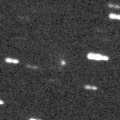
|
Now it is bright as 14.8 mag (Dec. 12, Kunihiro Shima). It stays 14 mag for a long time in 2019. In the Southern Hemisphere, it is observable in excellent condition. In the Northern Hemisphere, it is not observasble until summer in 2020.
Date(TT) R.A. (2000) Decl. Delta r Elong. m1 Best Time(A, h)
Mar. 2 9 37.83 -59 40.3 2.747 3.241 111 14.3 22:56 ( 0, -5)
Mar. 9 9 14.91 -60 13.4 2.730 3.220 110 14.3 22:05 ( 0, -5)
|
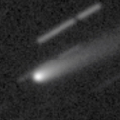
|
Now it is 13.9 mag (Feb. 9, Chris Wyatt). It will be fading after this, and it will be fainter than 18 mag in May.
Date(TT) R.A. (2000) Decl. Delta r Elong. m1 Best Time(A, h)
Mar. 2 11 39.58 -6 11.0 0.836 1.803 161 14.5 1:04 ( 0, 49)
Mar. 9 11 35.05 -5 45.6 0.849 1.832 168 14.7 0:32 ( 0, 49)
|
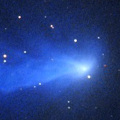
|
Now it is 15.2 mag (Feb. 1, Toshihiko Ikemura, Hirohisa Sato).It will be fading slowly after this. It is observable in good condition in the Northern Hemisphere. In the Southern Hemisphere, it stays extremely low for a while.
Date(TT) R.A. (2000) Decl. Delta r Elong. m1 Best Time(A, h)
Mar. 2 16 5.20 45 11.5 3.640 3.983 103 14.5 5:05 (202, 79)
Mar. 9 16 4.51 45 55.3 3.649 4.033 105 14.6 4:56 (184, 79)
|
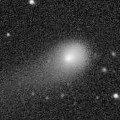
|
Now it is 14.5 mag (Jan. 31, Toshihiko Ikemura, Hirohisa Sato). It will be fading slowly after this. It is observable in excellent condition until spring in the Northern Hemispehre. In the Southern Hemisphere, it will be hardly observable after this.
Date(TT) R.A. (2000) Decl. Delta r Elong. m1 Best Time(A, h)
Mar. 2 9 51.32 44 13.4 4.140 4.951 141 14.7 23:11 (180, 81)
Mar. 9 9 38.89 43 53.0 4.232 4.989 135 14.8 22:31 (180, 81)
|

|
Now it is 14.5 mag (Aug. 16, P. Camilleri, H. Williams). It stays 15 mag from 2018 to 2019, and it will be observable for a long time in the Southern Hemisphere. In the Northern Hemisphere, it will never be observable again.
Date(TT) R.A. (2000) Decl. Delta r Elong. m1 Best Time(A, h)
Mar. 2 22 23.83 -55 27.1 4.519 3.928 48 14.9 5:05 (318,-34)
Mar. 9 22 37.14 -54 15.7 4.495 3.933 50 14.9 4:56 (317,-33)
|

|
Now it is 14.2 mag (Feb. 4, ATLAS-MLO, Mauna Loa). It will be fading gradually after this. It is observable in excellent condition in the Northern Hemisphere. In the Southern Hemisphere, it is not observable until summer.
Date(TT) R.A. (2000) Decl. Delta r Elong. m1 Best Time(A, h)
Mar. 2 9 47.53 75 57.8 1.759 2.307 111 15.0 23:07 (180, 49)
Mar. 9 9 34.35 73 26.8 1.814 2.343 109 15.1 22:27 (180, 52)
|
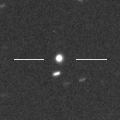
|
Now it is 14.5 mag (Jan. 27, Toshihiko Ikemura, Hirohisa Sato). It is expected to brighten up to 7-8 mag in 2020. It will be unobservable temporarily in April.
Date(TT) R.A. (2000) Decl. Delta r Elong. m1 Best Time(A, h)
Mar. 2 3 2.25 1 55.8 5.494 5.133 63 15.3 19:19 ( 61, 38)
Mar. 9 3 4.48 2 45.9 5.531 5.071 57 15.3 19:25 ( 68, 32)
|
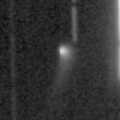
|
Now it is 14.6 mag (Jan. 21, Sandor Szabo). It will be fading after this. It is observable in good condition in the Northern Hemisphere. It is not observable at all in the Southern Hemisphere.
Date(TT) R.A. (2000) Decl. Delta r Elong. m1 Best Time(A, h)
Mar. 2 3 50.15 63 47.5 3.151 3.308 90 15.7 19:19 (156, 55)
Mar. 9 3 44.55 61 27.4 3.277 3.318 83 15.8 19:25 (148, 53)
|
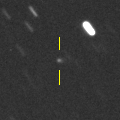
|
It is expected to brighten up to 10 mag in autumn. Now it is 16.7 mag (Feb. 1, Toshihiko Ikemura, Hirohisa Sato). In the Northern Hemisphere, it stays observable for a long time while the comet is brightening. In the Southern Hemisphere, it it not observable until mid September.
Date(TT) R.A. (2000) Decl. Delta r Elong. m1 Best Time(A, h)
Mar. 2 15 34.34 84 54.1 2.535 2.864 99 16.1 4:53 (180, 40)
Mar. 9 17 40.79 88 19.1 2.533 2.794 94 16.0 4:56 (181, 37)
|

|
First return of a new periodic comet discovered in 2014. The condition of this apparition is excelllent. It was expected to brighten rapidly, and to be observable at 15.5 mag in excellent condition in March. But it has not been recovered yet. Now it is not detected, fainter than 20.0 mag (Dec. 10, Toshihiko Ikemura, Hirohisa Sato).
Date(TT) R.A. (2000) Decl. Delta r Elong. m1 Best Time(A, h)
Mar. 2 10 15.00 9 38.2 0.804 1.789 171 16.1 23:35 ( 0, 65)
Mar. 9 10 11.10 10 22.7 0.797 1.770 163 16.0 23:03 ( 0, 65)
|
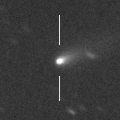
|
Although it was faint as 16-17 mag in November, it brightened up to 14.7 mag in December (Dec. 12, Toshihiko Ikemura, Hirohisa Sato). It is bright as 15.1 mag still now (Jan. 31, Toshihiko Ikemura, Hirohisa Sato). In the Northern Hemisphere, it stays observable in excellent condition after this. It stays extremely low in the Southern Hemisphere.
Date(TT) R.A. (2000) Decl. Delta r Elong. m1 Best Time(A, h)
Mar. 2 10 56.11 43 8.6 2.135 2.996 144 16.1 0:20 (180, 82)
Mar. 9 10 49.50 43 19.1 2.190 3.027 141 16.2 23:42 (180, 82)
|
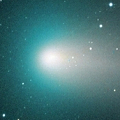
|
It brightened up to 6.8 mag in September (Sept. 17, Seiichi Yoshida). Now it is fading. It has already faded down to 15.3 mag (Jan. 30, Toshihiko Ikemura, Hirohisa Sato). It is observable in excellent condition in the Southern Hemisphere.
Date(TT) R.A. (2000) Decl. Delta r Elong. m1 Best Time(A, h)
Mar. 2 6 15.25 -17 37.0 1.826 2.329 107 16.4 19:36 ( 0, 38)
Mar. 9 6 20.61 -15 34.4 1.942 2.389 104 16.7 19:25 ( 3, 39)
|
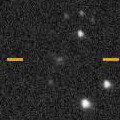
|
Now it is 17.4 mag (Jan. 3, Toshihiko Ikemura, Hirohisa Sato). It stays 16 mag for a long time from 2019 to 2020. It is observable in excellent condition in the Southern Hemisphere. It is hardly observable in the Northern Hemisphere.
Date(TT) R.A. (2000) Decl. Delta r Elong. m1 Best Time(A, h)
Mar. 2 14 6.39 -49 21.6 3.840 4.264 108 16.7 3:30 ( 0, 6)
Mar. 9 13 59.46 -51 5.1 3.726 4.228 114 16.6 2:56 ( 0, 4)
|

|
Now it is 16.8 mag (Jan. 31, Toshihiko Ikemura, Hirohisa Sato). It stays 16-17 mag for a long time until 2020. It is observable in good condition in the Northern Hemisphere. It is not observable at all in the Southern Hemisphere.
Date(TT) R.A. (2000) Decl. Delta r Elong. m1 Best Time(A, h)
Mar. 2 11 28.43 74 20.1 8.010 8.445 112 16.7 0:53 (180, 51)
Mar. 9 11 21.25 74 15.7 8.046 8.446 110 16.7 0:18 (180, 51)
|
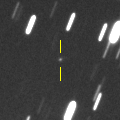
|
Now it is 16.6 mag (Feb. 1, Toshihiko Ikemura, Hirohisa Sato). It continues brightening even after the perihelion passage. It stays observable at 16-17 mag in good condition for some more time.
Date(TT) R.A. (2000) Decl. Delta r Elong. m1 Best Time(A, h)
Mar. 2 8 10.43 -2 15.2 0.859 1.735 139 16.7 21:31 ( 0, 53)
Mar. 9 8 15.25 -1 56.2 0.914 1.759 134 16.8 21:09 ( 0, 53)
|
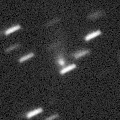
|
It brightened up to 8.7 mag in July (July 18, Marco Goiato). Now it is 19.9 mag (Feb. 28, Jean-Francois Soulier). It stays observable in good condition after this while the comet will be fading. But actually, it is fainter than this ephemeris.
Date(TT) R.A. (2000) Decl. Delta r Elong. m1 Best Time(A, h)
Mar. 2 16 27.65 -12 50.8 3.235 3.441 93 16.9 5:05 (345, 41)
Mar. 9 16 26.01 -11 38.3 3.193 3.521 101 17.0 4:56 (351, 43)
|

|
Now it is 16.8 mag (Feb. 1, Toshihiko Ikemura, Hirohisa Sato). It is observable at 17 mag in good condition in 2019. It locates somewhat low in the Northern Hemisphere.
Date(TT) R.A. (2000) Decl. Delta r Elong. m1 Best Time(A, h)
Mar. 2 15 53.85 -16 18.8 3.470 3.786 101 17.1 5:05 (356, 39)
Mar. 9 15 56.00 -16 24.8 3.376 3.794 107 17.1 4:52 ( 0, 39)
|
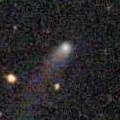
|
It brightened up to 14.7 mag in early 2018 (Jan. 25, Catalina Sky Survey). Now it is fading slowly. Now it is 16.7 mag (Feb. 2, Toshihiko Ikemura, Hirohisa Sato). In the Northern Hemisphere, it stays observable in good condition for a long time until the comet fades out. It is never observable again in the Southern Hemisphere.
Date(TT) R.A. (2000) Decl. Delta r Elong. m1 Best Time(A, h)
Mar. 2 4 13.55 69 28.9 6.177 6.323 93 17.2 19:19 (165, 53)
Mar. 9 4 9.76 68 51.5 6.295 6.350 88 17.2 19:25 (161, 51)
|

|
Now it is 17.2 mag (Feb. 2, Toshihiko Ikemura, Hirohisa Sato). Fading slowly. It stays observable at 17 mag in good condition until summer.
Date(TT) R.A. (2000) Decl. Delta r Elong. m1 Best Time(A, h)
Mar. 2 11 38.10 8 19.8 9.039 10.011 167 17.2 1:02 ( 0, 63)
Mar. 9 11 36.63 8 40.1 9.035 10.022 173 17.2 0:33 ( 0, 64)
|
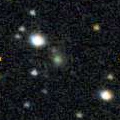
|
Now it is 16.9 mag (Feb. 2, Toshihiko Ikemura, Hirohisa Sato). It is expected to be observable at 5-6 mag for a long time from 2022 to 2023. It will be observable in good condition for a long time in the Southern Hemisphere. In the Northern Hemisphere, it is not observable at the highlight from 2022 summer to 2023 summer.
Date(TT) R.A. (2000) Decl. Delta r Elong. m1 Best Time(A, h)
Mar. 2 18 11.16 53 39.7 12.217 12.158 84 17.3 5:05 (223, 58)
Mar. 9 18 12.51 54 5.7 12.148 12.113 85 17.3 4:56 (220, 60)
|
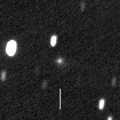
|
Now it is 17.0 mag (Feb. 1, Toshihiko Ikemura, Hirohisa Sato). It will be fading after this, and it will be fainter than 18 mag in May. It locates very low in the Southern Hemisphere.
Date(TT) R.A. (2000) Decl. Delta r Elong. m1 Best Time(A, h)
Mar. 2 5 47.49 43 3.8 3.557 3.943 105 17.4 19:19 (167, 82)
Mar. 9 5 50.60 42 49.5 3.667 3.957 99 17.5 19:25 (138, 79)
|
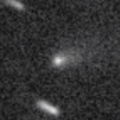
|
Now it is 17.1 mag (Feb. 1, Toshihiko Ikemura, Hirohisa Sato). It will be fading after this, and it will be fainter than 18 mag in March.
Date(TT) R.A. (2000) Decl. Delta r Elong. m1 Best Time(A, h)
Mar. 2 7 51.17 21 25.6 1.878 2.671 134 17.5 21:12 ( 0, 76)
Mar. 9 7 51.39 20 59.8 1.968 2.695 127 17.6 20:45 ( 0, 76)
|
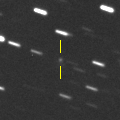
|
Now it is 17.6 mag (Jan. 30, Toshihiko Ikemura, Hirohisa Sato). It stays 17 mag from spring to summer. But it is hardly observable. In the Northern Hemisphere, it is observable only until May. In the Southern Hemisphere, it stays locating extremely low.
Date(TT) R.A. (2000) Decl. Delta r Elong. m1 Best Time(A, h)
Mar. 2 4 15.31 44 42.7 2.405 2.590 89 17.5 19:19 (124, 68)
Mar. 9 4 26.49 43 56.5 2.439 2.546 84 17.5 19:25 (120, 65)
|
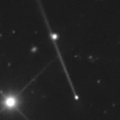
|
Main-belt asteroid. But it shows a straight tail like a comet. Now it is 17.3 mag (Feb. 4, Toshihiko Ikemura, Hirohisa Sato). It stays observable in excellent condition until early summer.
Date(TT) R.A. (2000) Decl. Delta r Elong. m1 Best Time(A, h)
Mar. 2 10 20.93 -7 4.3 1.395 2.363 163 17.5 23:40 ( 0, 48)
Mar. 9 10 14.87 -5 15.1 1.384 2.348 161 17.5 23:07 ( 0, 50)
|
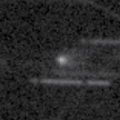
|
Now it is 17.0 mag (Jan. 29, Toshihiko Ikemura, Hirohisa Sato). It will be fading after this, and it will be fainter than 18 mag in March. It locates low in the Southern Hemisphere.
Date(TT) R.A. (2000) Decl. Delta r Elong. m1 Best Time(A, h)
Mar. 2 10 48.13 31 50.8 1.961 2.893 155 17.6 0:12 ( 0, 87)
Mar. 9 10 41.71 32 15.5 2.022 2.933 151 17.7 23:34 ( 0, 87)
|
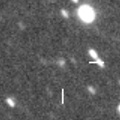
|
Now it is 18.2 mag (Oct. 8, Toshihiko Ikemura, Hirohisa Sato). It will brighten up to 16.5 mag in June. It is observable in excellent condition in the Southern Hemisphere. It locates low in the Northern Hemisphere.
Date(TT) R.A. (2000) Decl. Delta r Elong. m1 Best Time(A, h)
Mar. 2 18 55.03 -23 49.1 4.443 4.012 58 17.8 5:05 (315, 15)
Mar. 9 18 55.78 -24 34.3 4.299 3.986 65 17.7 4:56 (319, 17)
|
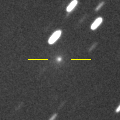
|
Now it is 16.8 mag (Jan. 29, Toshihiko Ikemura, Hirohisa Sato). It will be fading after this, and it will be fainter than 18 mag in March.
Date(TT) R.A. (2000) Decl. Delta r Elong. m1 Best Time(A, h)
Mar. 2 5 11.12 28 16.9 1.394 1.824 98 17.7 19:19 ( 59, 78)
Mar. 9 5 24.47 29 47.0 1.475 1.840 94 18.0 19:25 ( 75, 75)
|

|
Now it is 17.7 mag (Feb. 2, Toshihiko Ikemura, Hirohisa Sato). In the Northern Hemisphere, it is observable at 17.5 mag in good condition in February. It is not observable in the Southern Hemisphere.
Date(TT) R.A. (2000) Decl. Delta r Elong. m1 Best Time(A, h)
Mar. 2 5 16.80 44 20.6 1.113 1.615 100 17.8 19:19 (141, 78)
Mar. 9 5 4.00 36 25.4 1.250 1.604 90 18.0 19:25 (100, 72)
|

|
First return of a new periodic comet which brightened up to 16.5 mag in 2005. It will brighten up to 17.5 mag in spring.
Date(TT) R.A. (2000) Decl. Delta r Elong. m1 Best Time(A, h)
Mar. 2 13 22.61 -10 7.0 2.407 3.212 137 18.0 2:46 ( 0, 45)
Mar. 9 13 21.31 -10 3.1 2.323 3.190 145 17.9 2:17 ( 0, 45)
|
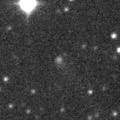
|
It was observed at 16 mag from 2017 to 2018. Now it is fading. It is observable at 18 mag in good condition in this spring.
Date(TT) R.A. (2000) Decl. Delta r Elong. m1 Best Time(A, h)
Mar. 2 16 8.06 5 48.2 7.128 7.380 100 17.9 5:05 (347, 60)
Mar. 9 16 8.40 6 38.2 7.055 7.408 107 17.9 4:56 (356, 62)
|
|
![]()
 C/2017 T2 ( PanSTARRS )
C/2017 T2 ( PanSTARRS ) C/2018 A3 ( ATLAS )
C/2018 A3 ( ATLAS ) C/2018 W2 ( Africano )
C/2018 W2 ( Africano ) P/2014 C1 ( TOTAS )
P/2014 C1 ( TOTAS ) 240P/NEAT
240P/NEAT 21P/Giacobini-Zinner
21P/Giacobini-Zinner C/2018 F4 ( PanSTARRS )
C/2018 F4 ( PanSTARRS ) C/2010 U3 ( Boattini )
C/2010 U3 ( Boattini ) 239P/LINEAR
239P/LINEAR C/2017 T3 ( ATLAS )
C/2017 T3 ( ATLAS ) 74P/Smirnova-Chernykh
74P/Smirnova-Chernykh C/2016 A1 ( PanSTARRS )
C/2016 A1 ( PanSTARRS ) C/2014 B1 ( Schwartz )
C/2014 B1 ( Schwartz ) C/2017 K2 ( PanSTARRS )
C/2017 K2 ( PanSTARRS ) 159P/LONEOS
159P/LONEOS 59P/Kearns-Kwee
59P/Kearns-Kwee C/2018 X2 ( Fitzsimmons )
C/2018 X2 ( Fitzsimmons ) (6478) Gault
(6478) Gault 164P/Christensen
164P/Christensen C/2018 KJ3 ( Lemmon )
C/2018 KJ3 ( Lemmon ) 171P/Spahr
171P/Spahr C/2019 B1 ( Africano )
C/2019 B1 ( Africano ) P/2018 X1 ( LONEOS )
P/2018 X1 ( LONEOS ) C/2017 E3 ( PanSTARRS )
C/2017 E3 ( PanSTARRS )![]()





































